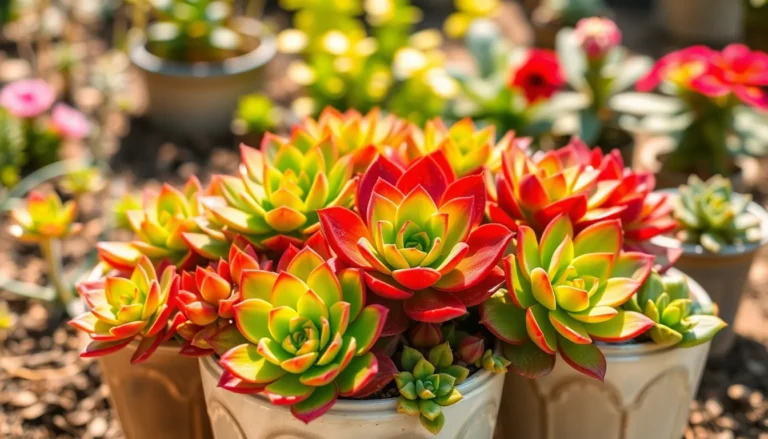In a world where food trends come and go faster than you can say “kale smoothie,” edible succulents are making a splash that’s hard to ignore. These quirky plants, often relegated to the realm of home decor, are stepping into the culinary spotlight. Imagine munching on a vibrant, juicy leaf that not only adds a pop of color to your plate but also packs a nutritional punch. Who knew your garden could double as a salad bar?
Edible Succulents
Edible succulents refer to a diverse group of succulent plants that are safe to consume and contribute unique flavors and textures to dishes. Examples include varieties such as Haworthia, Sedum, and Aloe Vera, each offering specific culinary applications. These plants thrive in arid conditions, storing water within their leaves, which also contain essential nutrients.
Incorporating them into meals enhances both visual appeal and flavor profiles. Chefs and home cooks appreciate the crispness and slightly tangy taste of many edible succulents, enriching salads, salsas, and other dishes. For instance, Sedum leaves add a refreshing crunch, while Aloe Vera provides a mild flavor ideal for smoothies.
Nutritional benefits accompany the culinary advantages of edible succulents. Many contain vitamins A, C, E, and several B vitamins. Minerals like calcium, potassium, and magnesium also contribute to their health benefits, making them an excellent addition to a balanced diet.
Culinary cultures around the world utilize these plants in various ways. In Mexico, people often include nopal cactus pads in traditional dishes. Additionally, Asian cuisines incorporate Aloe Vera in desserts and beverages.
Factors such as growing conditions and preparation methods impact the flavor and nutritional value of edible succulents. Picking them fresh ensures the best taste and maximum nutrients. Using them in cooking not only elevates dishes but also promotes sustainable gardening practices, making them a valuable resource for both professional chefs and home cooks.
Popular Types of Edible Succulents

Edible succulents come in various types, each with distinct flavors and uses in culinary applications.
Cacti
Cacti provide a unique flavor and a crunchy texture. Nopal cactus, commonly found in Mexican cuisine, offers pads that are rich in fiber and low in calories. These pads are versatile and can be grilled, sautéed, or used in salads. The fruit, or prickly pear, is sweet and juicy, perfect for desserts or beverages. Chefs enjoy using both parts, incorporating them into salsas and tacos for a refreshing twist. Nutritionally, nopales are high in vitamins A and C, along with antioxidants, making them a nutritious choice.
Aloe Vera
Aloe Vera adds a refreshing taste and numerous health benefits. Its gel is commonly used in smoothies and drinks for hydration and digestive health. This succulent contains vitamins, amino acids, and enzymes that enhance well-being. In Asian cuisines, Aloe Vera appears in desserts and herbal teas, providing a unique texture and slight sweetness. Cooking with Aloe Vera offers versatility as it complements both sweet and savory dishes. Many consider its anti-inflammatory properties a significant health advantage.
Hens and Chicks
Hens and Chicks are not only decorative but also edible with a mild taste. They stand out as a nutrient-dense option, packed with vitamins A and C, and minerals like calcium. These plants thrive in various climates, making them an accessible choice for gardeners. Their leaves can be used in salads or as garnishes, adding visual appeal. Some use them in soups or stir-fries, enhancing flavor profiles with an intriguing texture. Chefs appreciate their adaptability, making them popular in contemporary cuisine.
Nutritional Benefits of Edible Succulents
Edible succulents offer numerous nutritional advantages that enhance their appeal beyond mere aesthetics. Rich in vitamins A, C, E, and several B vitamins, they support overall health.
Health Benefits
These plants also provide essential minerals, including calcium, potassium, and magnesium. Calcium helps maintain strong bones, while potassium regulates blood pressure. Incorporating edible succulents into diets boosts hydration due to their high water content, supporting metabolic processes and skin health. Many varieties, like nopal cactus, contain fiber, promoting digestive health. Aloe Vera, known for its anti-inflammatory properties, aids in gut health and supports immune function. Nutritional benefits combine to make edible succulents an excellent choice for a balanced diet.
Culinary Uses
Culinary applications for edible succulents are diverse and exciting. Chefs incorporate them into salads, smoothies, and main dishes, enhancing flavors and textures. Nopal cactus pads add a crunchy element to tacos, while prickly pear fruit serves as a sweet topping for desserts. Aloe Vera gel can be blended into beverages, providing refreshing options. Hens and Chicks work well in tosses or as garnishes, offering both visual appeal and nutritional benefits. The versatility of these plants elevates both traditional and contemporary dishes, showcasing their unique characteristics in global cuisine.
How to Grow Edible Succulents at Home
Growing edible succulents at home offers a rewarding experience. These unique plants require minimal effort to flourish under appropriate conditions.
Planting Tips
Start by selecting a well-draining soil mix, ideally designed for cacti and succulents. Place the chosen containers in areas that receive ample sunlight, with six hours of direct light preferred daily. Choose varieties such as Haworthia and Sedum for a diverse array of flavors. Use seeds or cuttings for propagation, with cuttings being easier and faster to establish. Ensure adequate spacing between plants to promote airflow and prevent rot. Water sparingly after planting to encourage deep root growth while avoiding over-saturation.
Maintenance and Care
Watering needs differ among succulent species. Most thrive when watered once every two weeks during growing seasons and even less during dormancy. Fertilizing once or twice a year with a diluted succulent fertilizer supports growth without overwhelming the plants. Pruning helps maintain shape and encourages new growth, particularly in overgrown or leggy plants. Watch for pests like mealybugs or aphids, as early detection aids in control. When harvesting, only take what is necessary, allowing the plant to regenerate effectively.
Conclusion
Edible succulents offer a delightful fusion of flavor and nutrition that can transform any meal. Their unique textures and vibrant colors not only enhance dishes but also contribute essential vitamins and minerals. As culinary trends continue to embrace these plants, both chefs and home cooks can explore innovative ways to incorporate them into their recipes.
Growing edible succulents at home is an accessible and rewarding endeavor. With minimal care needed, gardeners can cultivate their own supply of fresh ingredients. This sustainable approach not only promotes healthy eating but also adds beauty to any garden space. Embracing edible succulents is a step towards a more flavorful and health-conscious culinary experience.





